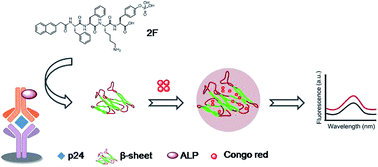Peptidic β-sheets induce Congo red-derived fluorescence to improve the sensitivity of HIV-1 p24 detection
Abstract
At the early stage of HIV infection, the low concentration of HIV components seriously hinders the diagnosis of this fatal disease. Improving the sensitivity of detection thus becomes the only approach to effectively detect HIV infection at the early stages. We use alkaline phosphatase to catalyze short peptides that contain a 2-phenylalanine core component (2F) to form β-sheets which can combine with Congo red to produce a strong fluorescent signal. For the detection of HIV-1 p24, the limit of detection of 2F-Congo red reaches 2.44 pg ml−1, which is lower than that of clinical ELISA (5 pg ml−1). The inter-batch variability, intra-batch variability and precision of 2F-Congo red for HIV detection are 5.4%, 2.3% and 2.9%, respectively, which are similar to those of clinical ELISA (4.1%, 2.7% and 3.2%, respectively). The variability and precision of 2F-Congo red is consistent to that of clinical ELISA for quantifying HIV-1 p24. 2F-Congo red thus shows a better performance for the detection of HIV infection at the early stages, as detection by clinical ELISA is difficult at the early stages of infection.



 Please wait while we load your content...
Please wait while we load your content...